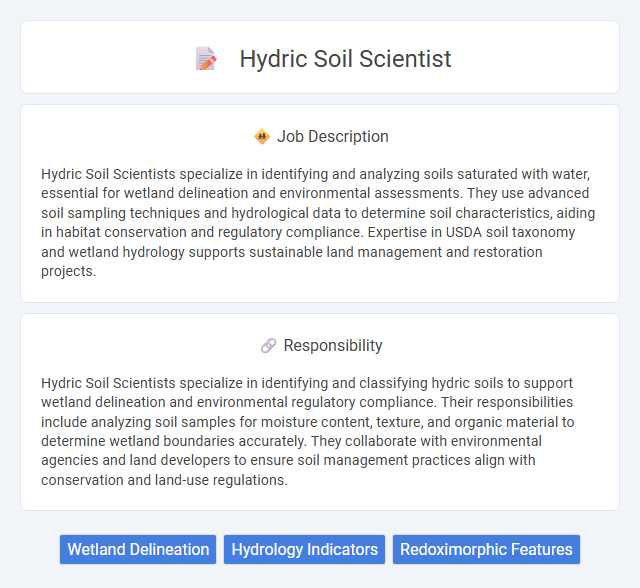
Hydric Soil Scientists specialize in identifying and analyzing soils saturated with water, essential for wetland delineation and environmental assessments. They use advanced soil sampling techniques and hydrological data to determine soil characteristics, aiding in habitat conservation and regulatory compliance. Expertise in USDA soil taxonomy and wetland hydrology supports sustainable land management and restoration projects.
Individuals with a strong interest in environmental science and attention to detail are likely to find the role of a Hydric Soil Scientist suitable. Candidates comfortable with fieldwork in various weather conditions and who possess analytical skills for soil evaluation may have a higher chance of success. Those who prefer desk-based roles or have limited physical stamina might find the job less compatible with their preferences.
Qualification
A Hydric Soil Scientist typically holds a bachelor's or master's degree in soil science, environmental science, geology, or related fields, with specialized coursework in wetland soil properties and hydrology. Professional certifications such as the Certified Professional Soil Scientist (CPSS) or Wetland Professional in Training (WPIT) enhance job prospects and demonstrate expertise. Experience in field sampling, soil analysis, and proficiency with Geographic Information Systems (GIS) tools are essential qualifications for accurate soil assessment and wetland delineation.
Responsibility
Hydric Soil Scientists specialize in identifying and classifying hydric soils to support wetland delineation and environmental regulatory compliance. Their responsibilities include analyzing soil samples for moisture content, texture, and organic material to determine wetland boundaries accurately. They collaborate with environmental agencies and land developers to ensure soil management practices align with conservation and land-use regulations.
Benefit
A career as a Hydric Soil Scientist likely offers the benefit of contributing to environmental conservation and wetland preservation, which may provide a strong sense of professional fulfillment. There is a probable chance for competitive compensation and opportunities for fieldwork that can enhance practical experience and job satisfaction. This role may also offer prospects for collaboration with environmental agencies and research institutions, potentially broadening professional networks and career growth.
Challenge
Hydric soil scientists likely face the challenge of accurately identifying and classifying wetland soils amid changing environmental conditions. The complexity of soil saturation patterns and variability in moisture levels may require thorough field assessments and advanced analytical techniques. Navigating regulatory requirements while maintaining scientific precision could also pose ongoing difficulties.
Career Advancement
Hydric Soil Scientists can advance their careers by gaining expertise in wetland delineation, soil classification, and environmental compliance, which are critical for roles in environmental consulting and regulatory agencies. Pursuing certifications such as Certified Professional Soil Scientist (CPSS) enhances credibility and opens opportunities for leadership positions in natural resource management. Engaging in continuous education and interdisciplinary projects accelerates progression to senior scientist or project manager roles within governmental and private sectors.
Key Terms
Wetland Delineation
Hydric Soil Scientists specialize in identifying and analyzing soils saturated with water, crucial for wetland delineation and environmental compliance. They assess soil properties such as color, texture, and redoximorphic features to accurately determine wetland boundaries and classifications. Expertise in hydric soil indicators and federal wetland delineation manuals supports effective wetland conservation and regulatory permitting processes.
Hydrology Indicators
Hydric soil scientists specialize in identifying and analyzing hydrology indicators such as water saturation, soil moisture conditions, and redoximorphic features to determine wetland boundaries and assess soil-water interactions. They use tools like moisture probes, soil augers, and GIS mapping to monitor fluctuating water tables and seasonal flooding patterns critical for wetland delineation and environmental compliance. Their expertise supports wetland restoration, regulatory permitting, and habitat conservation by providing accurate data on hydric soil presence and hydrological influences.
Redoximorphic Features
Hydric Soil Scientists specialize in identifying and analyzing redoximorphic features, such as iron and manganese concretions, which indicate prolonged soil saturation and anaerobic conditions. These features are critical for determining wetland boundaries and assessing hydric soil properties in environmental and regulatory contexts. Expertise in soil morphology and redox chemistry allows accurate interpretation of soil saturation history, essential for environmental impact assessments.
 kuljobs.com
kuljobs.com